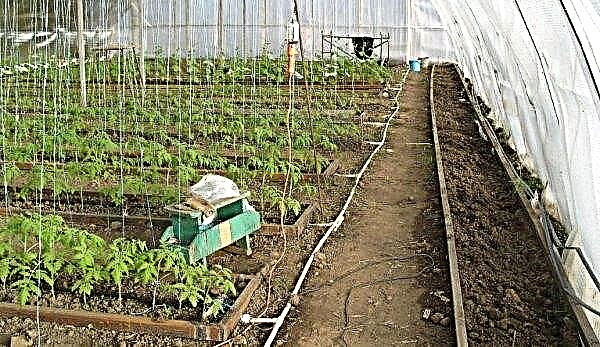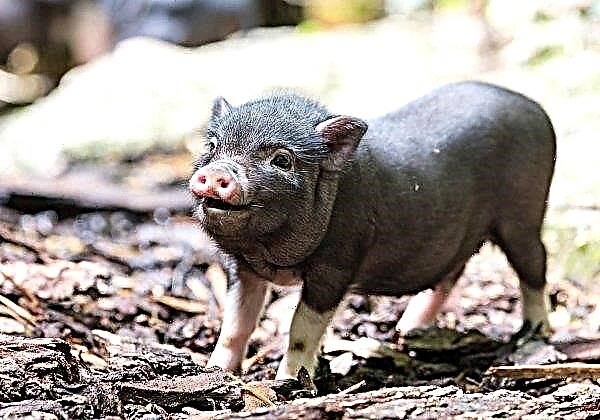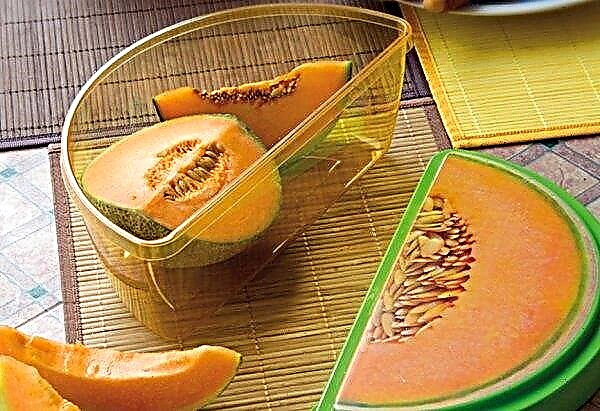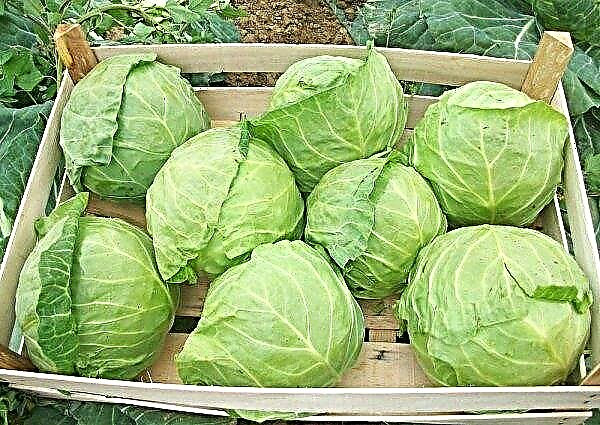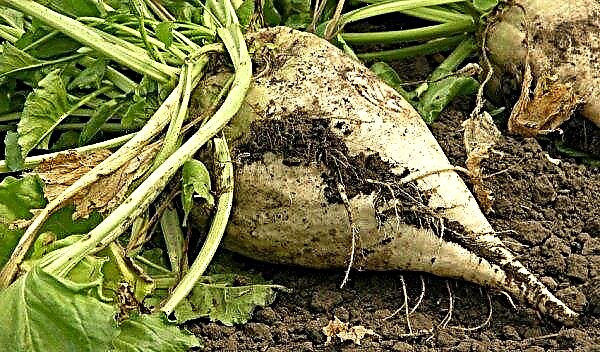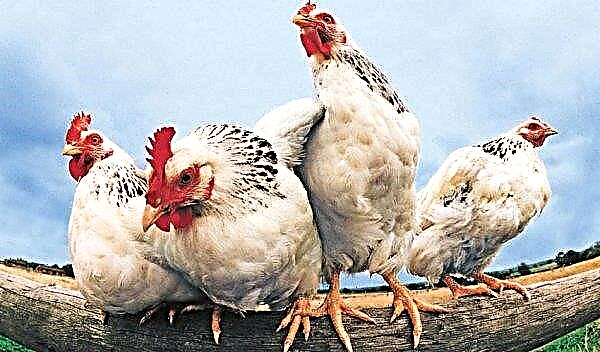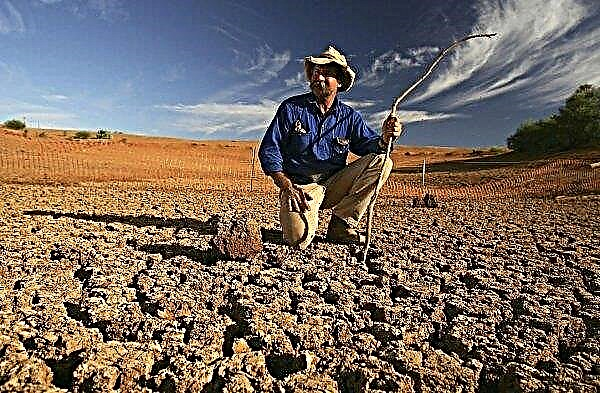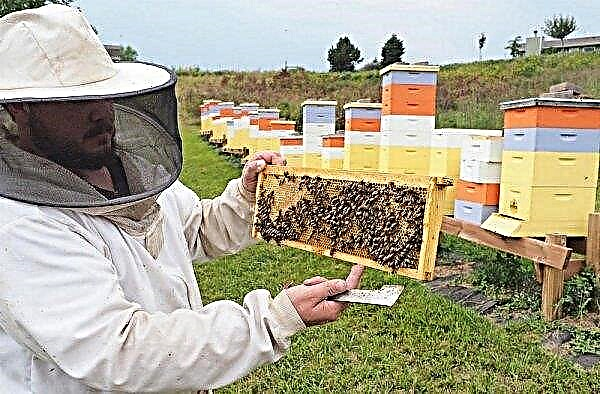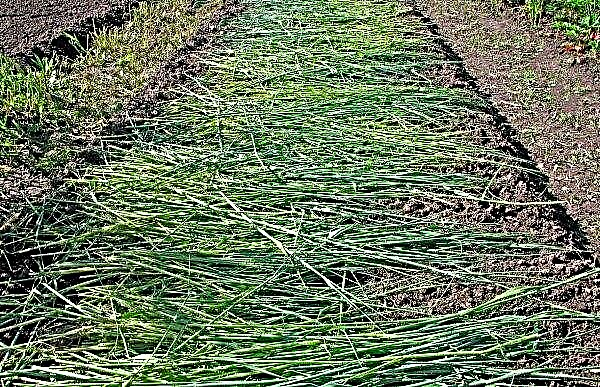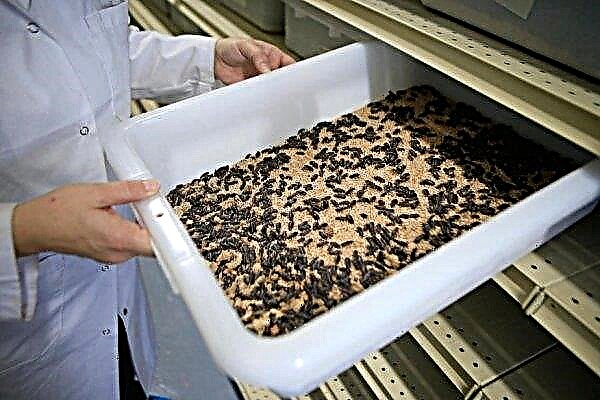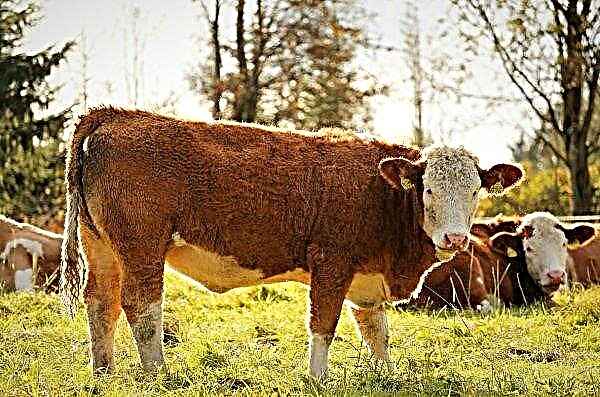Introduced in 1988, William's Pride is a beautiful dark red apple with white or creamy yellow flesh. These apple trees are resistant to many diseases and suitable for growing in winter hardiness zones. You will learn more about this variety from our review.
Botanical description and characterization of the variety
Williams Pride is a summer-ripening apple variety with attractive dark red fruits. Immunity to scab, excellent quality of medium and large fruits, which ripen very early, make it one of the most promising commercial varieties. It is named after Edwin B. Williams, professor emeritus and leader of the disease-resistant apple cultivar program at Purdue University (USA).

The variety refers to dessert. It is unique in that its apples, very juicy but hard, can be stored for up to 9 weeks without loss of quality. Apple trees almost do not crumble. The fruits are characterized by a deep rich taste and high juice content.
Did you know? 25% of the volume of apples is air, so they float in water and do not drown.
Description of fruits and tree
Fruit Characteristic:

- shape: oblate, approaching round, uniform;
- size: axial diameter - 64 mm, transverse diameter - 74 mm;
- color: in the stage of technical maturity - green, ripe apples - ruby red with weak stripes on the light side;
- weight: average - 150–170 g;
- peel: smooth, slightly waxy, medium thickness and stiffness;
- tail (apple stem): short - from 10 to 15 mm, thick, with notches;
- seeds: pointed;
- flesh: brittle, hard, with a rich taste;
- taste: slightly acidic;
- aroma: very weak;
- ripening season: summer, August;
- preservation: not less than 6 weeks;
- fruit tasting score: 4.8 points out of 5.
Apple Tree Williams Pride is powerful tree with great growth power and excellent branching of shoots. On annual shoots, the main fruiting occurs. Each of them is moderately loaded, so there is no need for manual or chemical thinning of the ovaries. The flowering period is longer than other varieties. Blooms Williams Pride raspberry color, which gradually turns into white. Flowering time is April. Fruiting occurs 3 years after planting a seedling.
Did you know? The term "apple" was used until the 1600s, as a general term for any fruit that was not a berry.
The height of the tree, as well as the yield, depends on the type of stock. Apple tree can be represented on stocks M-7a, M-26, MM-111. On the rootstock M-7a, the tree reaches a height of 3–3.2 m. It grows intensively before fruiting, and then stops its growth, directing all forces to bear fruit. The yield of this type of tree is 500-650 kg per 1 hundredth of the garden. M-111 is a semi-dwarf rootstock used to produce stunted trees. It has a powerful root system, high resistance to diseases and the same high drought tolerance. You can meet this apple tree on other types of stocks.
 Fruits Williams Pride have a high tasting rating
Fruits Williams Pride have a high tasting rating
Pros and cons of the variety
- Grade advantages:
- prolonged flowering allows you to use most varieties of apple trees as a pollinator;
- plentiful and regular fruiting;
- early harvest ripening;
- high commercial properties of fruits;
- high resistance to fungal diseases.
- The disadvantages of the variety:
- medium aphid infestation;
- planting a pollinator tree is required;
- like all summer varieties, Williams Pride apples are not stored for long.
Pollinators
Apple tree is able to bear fruit on its own. But such fruit formation is only 40% of the flowering volume. To increase the degree of pollination, gardeners plant another apple tree near the tree. It can be White filling or other varieties blooming in April. A feature of the variety is a longer flowering period than other apple trees. This simplifies the selection of pollinator.
 The flowering dates of apple trees selected as pollinators should coincide with the flowering dates of the variety
The flowering dates of apple trees selected as pollinators should coincide with the flowering dates of the variety
Average yield
The yield of one tree is about 70 kg of fruit. Please note that this indicator depends on the type of stock. M-7a - contributes better to the crop than others and in this case it is 500-650 kg / 100 m².
Grade stability
The variety is immune to scab. It is almost not affected by rust, moniliosis and a bacterial burn. During testing, the variety showed moderate or good resistance to powdery mildew. The tree is almost not affected by ticks, even if it is not sprayed with miticides.
Did you know? Some studies have linked eating apples to a reduced risk of cancer. Quercetin, proanthocyanidins, pectin and vitamin C, which are found in apples, will help you maintain good health and prevent the development of cancer cells.
Cultivation agricultural
On the resistance of trees to diseases affects the correct choice of a place for planting, as well as the correct implementation of basic agricultural practices. Among them: watering, fertilizing and preventive spraying from pests and diseases.
In order for the apple tree to be healthy and bring a good harvest, it is necessary:
- pick up a plot with bright lighting;
- make sure that during flowering the tree is protected from the cold northerly winds;
- organize a good drainage from the site;
- provide the tree with nutrients.
Video: Apple tree planting instructions
Seat selection
Basic requirements for the site:
- the presence of bright sunlight at least 6-8 hours a day;
- if the plot with the garden is even, then the tree is planted so that other trees or buildings from the cold side cover it from the cold wind;
- in hilly areas, landing is carried out on an elevation from the southern side of the hill;
- when the seedling reaches its maximum size, it should not have obstacles either under the roots (communications and trunk), or over the crown.
Did you know? Apples will help you get a beautiful and radiant complexion. Apple cider vinegar reduces oily skin, eliminating inflammation, acne, acne. It also restores the acid-base balance of the skin.
Soil drainage is essential for healthy roots., and with them the apple tree, so if the soil is clay, then it is diluted with sand. If it is very light and the water will go away too quickly, before it has time to nourish the roots, then do the opposite operation: add clay to the planting pit. It is not recommended to plant trees only on stony soils.
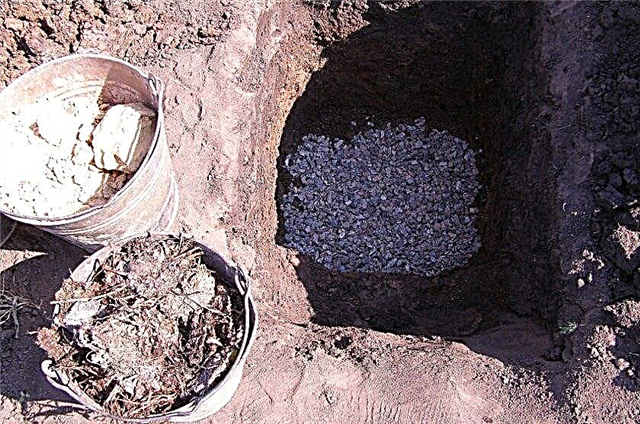 Using drainage to plant fruit tree
Using drainage to plant fruit tree
Selection of planting material
Selection of a seedling is an important stage in laying a garden. The more developed the root system, the more healthy will be the apple tree and abundant fruiting.
Video: How to choose the right apple seedling
A good seedling is characterized by:
- age 1-2 years;
- the presence of 5 or more developed branches;
- healthy smooth trunk;
- lack of damage to the trunk and branches;
- if any branch is broken during transportation, then at the cut the wood should be white, fibrous;
- powerful root system;
- the absence of darkened or softened roots, growths and other deformations on them;
- the absence of full buds.
The tree should not be one-sided, with branches that are not evenly distributed.
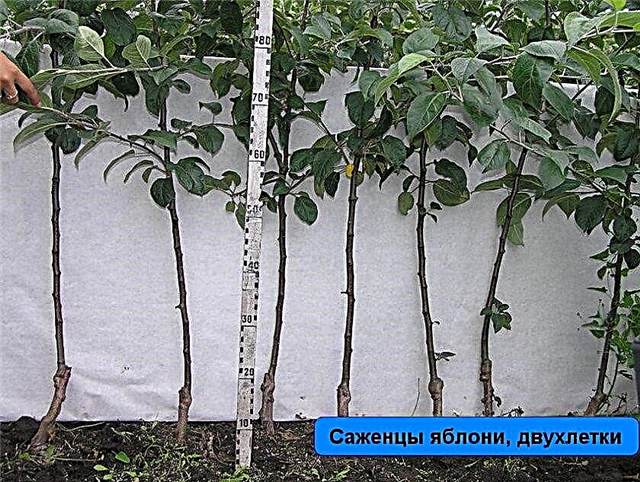
Direct landing technology
Planting dates for this variety: early spring (April-May) or mid-autumn (no later than mid-October). The temperature on the day of planting should be around + 10 ° C. If the day is rainy or frosty, postpone landing until the weather improves.
Important! It is forbidden to expose the roots to freezing temperatures. This will lead to the death of the seedling.
Landing technology:
- Dig the area by removing stones and weeds.
- Prepare the landing pits for Williams Pride and the pollinator tree at a distance of about 4 m from each other. The depth of the pit is about 0.8 m, the diameter is 0.5–0.8 m.
- Mix the upper part of the soil from the pit with a bucket of rotted manure and lay it on the bottom.
- Set the apple tree in the center of the pit.
- Next to her, set the stake to which she will be tied to give stability.
- Add soil to the pit and compact it around the apple tree.
- Pour the seedling.

Apple will need frequent watering in the first months of growth. The volume of water on 1 tree is 1 bucket. Frequency - 2-3 times a week.
Tree Care Rules
This variety is unpretentious in the care and cultivation. He does not suffer from frost, drought, lack of nutrient soil, or disease.
Despite this, tree care consists of:
- glaze;
- loosening the soil and removing weeds;
- fertilizing;
- trimming and forming crowns;
- harvesting;
- cleaning the garden and preparing the tree for winter.
Video: How to properly care for fruit trees
Frequency and rate of irrigation
One of the most common causes of tree death is an imbalance in supply and demand for water. If the tree does not have enough water, then drought stress arises, which is especially dangerous for young seedlings.
Stress from drought causes in young trees:
- withering, yellowing and falling of leaves;
- premature ripening of fruits or their decline.
Important! Some rhizomes are resistant to rot. So, the dwarf rhizome M-9 is relatively resistant to moisture problems, M-7 and M-111 are moderately stable, but the apple trees on stocks MM-104 and MM-106 — extremely sensitive and need special attention from the gardener.
The irrigation rate for a seedling is 1 bucket of water 2-3 times a week in the first year of growth, 1 bucket per week - for 2-3 years of growth. Since the beginning of fruiting - 2 buckets per week. Williams Pride is a drought tolerant variety. These apple trees will not suffer from drought, but try to follow the watering schedule.
Excess water is just as harmful as lack. Excessive moisture displaces oxygen from the soil, resulting in serious injury to the root system. The roots of the trees in the wetlands cease to grow, the minerals are not absorbed, the leaves turn yellow, become small and, finally, the roots begin to die. If they begin to rot, then it will be almost impossible to cure the tree. Gardeners are advised to remove such apple trees.

Dates and rates of fertilizer application
A healthy young tree gives an increase of 30-60 cm during the growing season. Measure the branches, and if so, then the tree does not need fertilizer. It receives from the soil all the necessary substances. If the growth is small, the tree needs nitrogen. It is a lot in fertilizers of organic origin or ammonium nitrate. Nitrogen promotes tree growth and root system development.
All fertilizers for the garden should contain nitrogen, phosphorus and potassium. If 9-3-0 is indicated on the package with fertilizers, this means that it contains 9% nitrogen, 3% phosphorus and no potassium. Nitrogen helps the growth of the green part of the plant. Phosphorus promotes root development and flowering. Potassium is involved in fruiting and seed development.
In the spring, before the start of the vegetative cycle, it is recommended to add ammonium nitrate in an amount of 40 g (or 600 g of urea). These substances are sources of nitrogen. Their introduction is mandatory if the tree has a small increase. In summer, 70 g of potassium sulfate or other potash fertilizers are added. The application time is May, when ovaries begin to form. After fruiting and harvest in August, superphosphate (40 g) or another source of phosphate fertilizer is added.

Crown trimming and shaping
Pruning is carried out in winter while the tree is resting. Its purpose is the formation of the correct crown and the removal of damaged branches. In spring, at the time of flowering, and in summer, trees are not pruned. Secateurs, delimbers or saws are used for trimming. Do not forget to disinfect the instrument with a solution of whiteness with water. This is necessary so as not to transfer phytopathogens from diseased trees to healthy ones when pruning.
Important! Avoid pruning in the fall, as this stimulates new branch growth, instead of preparing the tree for winter. These branches do not have time to lignify before winter and die.
In the process of work it is necessary:
- remove broken, dry or diseased branches - make an incision just above the point of connection of the branch with the trunk;
- trim branches that create a thickened crown;
- remove the tops (vertically extending shoots on the side branches);
- prune any branches that bend to the ground.
When the seedling reaches a height of 1 m, the central stem is shortened by 40 cm. This stimulates the development of lateral branches. These four side branches form the shape of a vase (tall glass). With this form, the illumination of each branch will be the same. The circulation of air in the crown will also be uniform.
 General principles of pruning apple trees
General principles of pruning apple trees
Winter preparations
To survive the freezing temperatures, the trees must be well prepared in the fall. Variety Williams Pride withstands frosts down to -27 ° C. To tolerate frost, tree branches are lignified. To ensure this process, apple trees stop watering and fertilizing after harvest.
The list of preparations for winter also includes:
- Cleaning the garden. You have to remove all fallen fruits, weeds, leaves, so as not to create an environment for wintering pests.
- All healthy and diseased fruits remaining on it are removed from the tree. They will certainly become drives for the wintering infection.
- Digging helps fight pests wintering in the ground and their larvae.
- Placing mulch in the root zone of fruit trees. It will serve as an insulating layer and will not allow the roots to freeze during frost.
- In the fall, the trunk is whitened in order to prevent the movement of pests between the crown and the soil. In the same quality, some gardeners use adhesive tape.
- In winter, a whitewash layer will protect the trunk from heating by sunlight and damage due to changes in day and night temperatures.
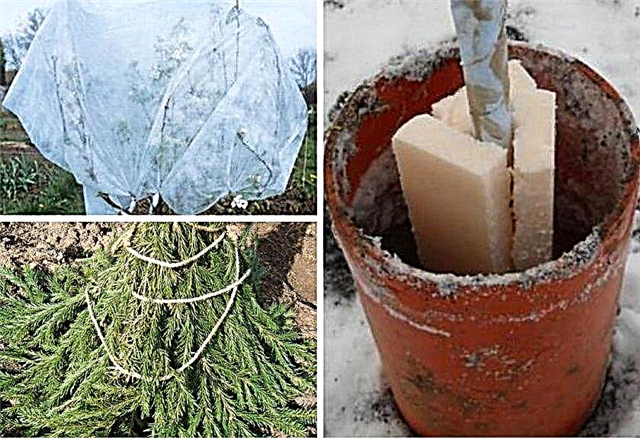
In winter, you will definitely have to shake off the snow from the branches. It not only breaks the branches by weight, but also at the time of the thaw turns into water, which can freeze and damage the fruit buds. Repeated cycles of frost and thaw can also lead to cracking of the bark and damage to the branches. Such branches will need to be removed during pruning, and the cracks on the trunks should be treated with copper sulphate and painted over with oil paint.
Grade Diseases and Pests
A large number of diseases are activated due to frequent rains, so the most effective prevention is the planting of varieties of apple trees that are resistant to diseases. Among them is Williams Pride. Maintaining a clean garden by removing diseased parts of trees slows down or stops the spread of disease.
The main diseases and pests of apple trees:
- Scab - identified by brown or olive-green spots on the leaves and black spots on the fruits. The disease weakens the tree and prevents the formation of flowers. One way to reduce the amount of scab spores is to grab the fallen leaves and remove them from the garden. This variety is immune to this disease.
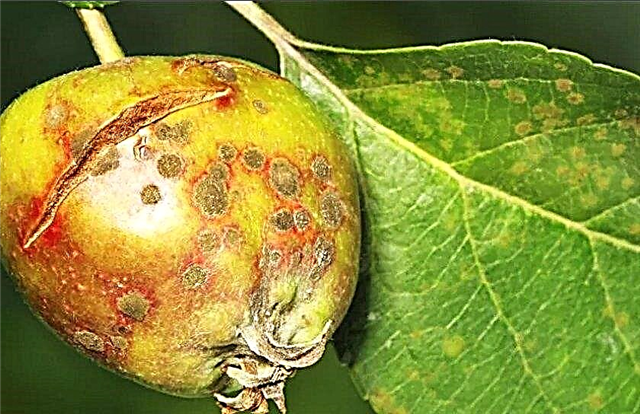
- Aphids and sooty fungi. Aphids are small, up to 2 mm, green insects that accumulate on leaves or their cuttings. They feed on the sap of plants, secreting a sticky coating, which becomes the environment for the development of soot fungus. His disputes are constantly present in the environment, but they appear only when certain conditions arise for this. The fungus looks like a group of tiny and well-defined black dots. The diameter of such spots may be different. After some time, they will cover the fetus completely. This will happen about a month after the initial infection. Warm and humid weather contributes to the spread of the disease.The use of fungicides from mid to late July with subsequent use in August ensures the safety of your apple trees. The most effective is considered "Captan" - contact fungicide from the class of phthalimides.
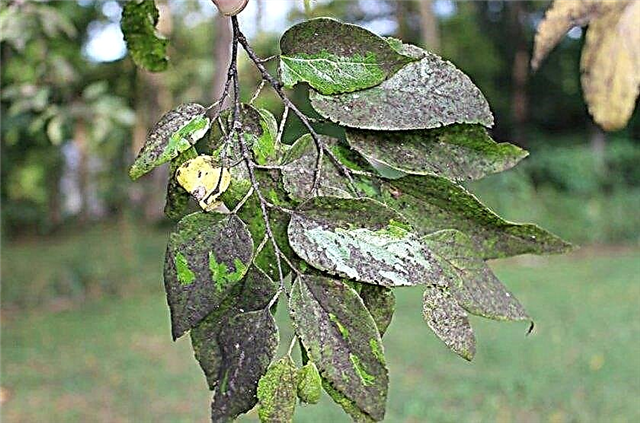
- Rust - Her symptoms appear on the foliage in the form of yellow or orange spots with a diameter of about ¼ inch. The disease spreads from late April to mid-June. Fungicides containing fenarimol or myclobutanil are effective against the disease. Variety Williams Pride has moderate resistance to this disease.
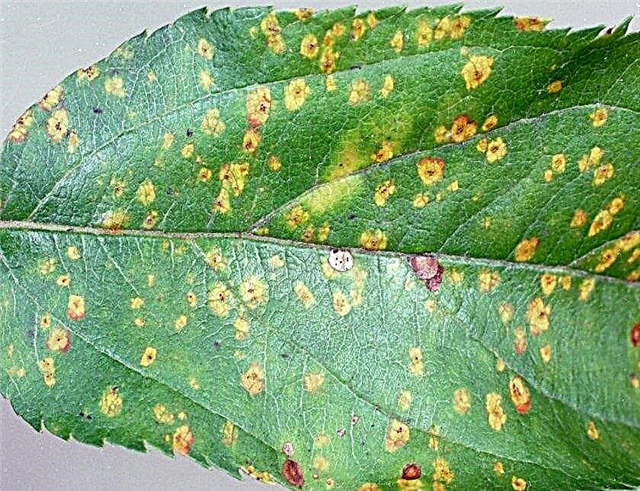
- Bacterial cancer - manifested as a result of damage to the trunk and branches in winter from frost. Branches with ulcers must be removed during pruning. Damage to the barrel is treated with copper sulfate and coated with oil paint to form a protective film.
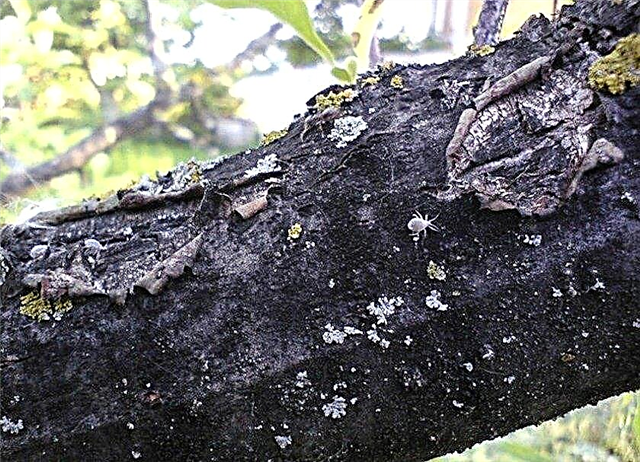
Insects can deprive the farmer of the crop if the trees are not sprayed from them. Unfortunately, varieties that would be resistant to insect damage do not exist, therefore, we recommend that you apply preventive measures to protect your apple trees.
The main group of funds is insecticides. There are general-purpose drugs that help against several varieties of pests, and drugs for specific insects. Using them, follow the packaging directions exactly and observe safety precautions.
Important! Insecticides can be used only after flowering, so as not to harm the bees. They are also forbidden to be used before harvesting (for 21 days).
The main pests:
- Moth - The main pest of apple orchards. Immediately after flowering, an adult moth lays eggs in an ovary. Larvae hatch from them, which will live in apples until they have to sink into the ground for wintering. On the surface of apples, you can see the points through which the pest got inside. And inside the fruit will be gnawed by a larva, which makes it unsuitable for commercial use. To prevent damage to the fruit, the first spraying from the codling moth is performed immediately after the apple trees bloom, and then it is repeated several times after 3 weeks. This is necessary because the moths of the second and third generation do not start flying at the same time, and you will not be able to spray right before the start of their flight.
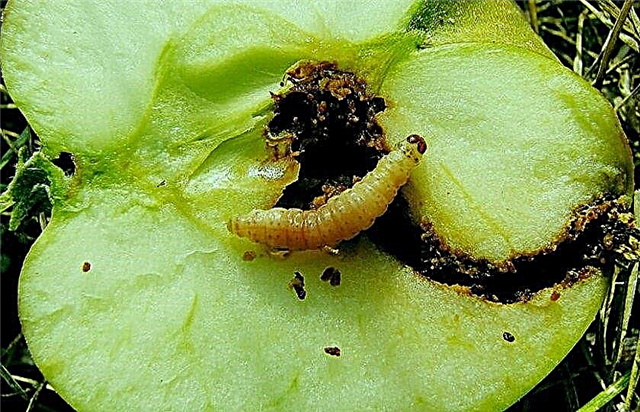
- European apple sawfly - Creates scars along the surface of the fetus and holes in its lateral part. Spraying from it must be carried out at the same time as when against the apple codling moth (preparations “Aktara”, “Confidor”, “Karbofos”, etc.). It should be borne in mind that eggs and larvae will be protected from insecticides and repellents, since they are inside the apple, so spraying is carried out immediately before the laying of eggs.
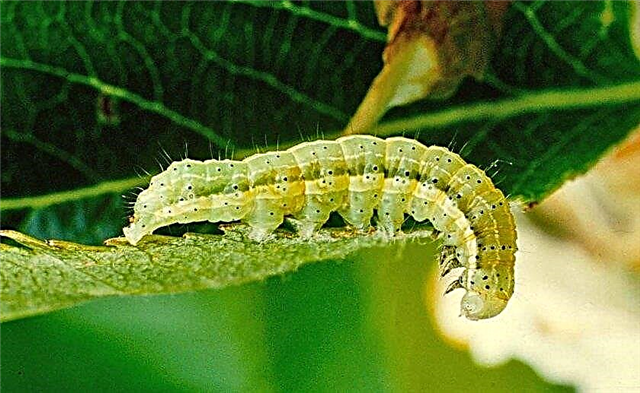
Farmers use insect traps to inflict maximum damage to flying pests.. These are structures inside coated with a sticky substance containing pheromones. Attracted insects remain on the sticky layer. The rate of trap placement is 1 per 100 apples. Consequently, about 4 traps will be needed for semi-dwarf varieties, and about 8–10 for tall plants. Traps should be suspended on a branch on the outside of the tree, surrounded by fruit, but not hidden by leaves.
Important! Use only those preparations that are intended for spraying apple trees. An improperly selected drug will not be able to show the declared effectiveness.
As the fruit ripens, some larvae move into the ground for wintering. To eliminate this, sticky tape is applied to the trunks of apple trees as a trapping belt.

Harvesting and storage
In technical maturity, most apples of this variety are green. As they mature, they acquire a dark ruby hue. In some sources, it is called dark red or dark purple. On this basis, you can determine the readiness of the fruits for collection. Even if they are not quite ripe, apples can be stored and ripen at the same time.
Apple picking rules:
- Take the fruit hanging on a branch in the palm of your hand. Turn it in one motion. You should have an apple in your hand.
- Do not pull the fruit with force, so as not to damage the branches on which the fruit buds of the future harvest are already laid.
- Sort the crop. Prepare damaged fruits for immediate processing. Divide the rest into large, medium and small and put in boxes.
- Store them at a temperature of 0 ° C and a humidity of 85%. Humidity allows the fruit to maintain freshness during storage.
- Remember that summer apples cannot be stored for longer than 2 months, and they must be either consumed fresh or processed.
 Williams Pride fruits are harvested in 2-3 doses
Williams Pride fruits are harvested in 2-3 doses
Variety Williams Pride is the owner of fruits that are excellent in taste and appearance. They are in the TOP 5 fruits for commercial use. Given that the apple tree is resistant to many diseases and unpretentious in care, choosing a variety of apple trees for planting on your site, try to choose it on it.
Network user reviews
I know Williams Pride well for about ten years. What immediately caught my eye was the very dull corners of the branches. If in many varieties you need to bend the branches, then in Williams Pride they themselves sag. Spindle effortlessly. Several times I meet on the forum that he is very vigorous. I think that it is not worth putting it on a par with Gloucesters, Florins, Eders. For the first years it grows energetically but from the second, third year it abundantly bears fruit. The branches bend and the main thing is not to overload too much. Some trees without proper care can weaken so much in growth that they look weak and give a mountain of small fruits. Do not shorten Williams unnecessarily in the early years and do not overload the fruits, and during the whole of August you eat beautiful fruits. Sometimes some fruits lie until September. Photo in the album.







